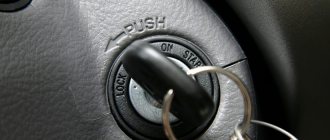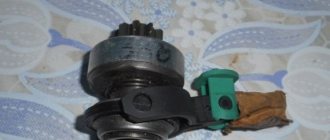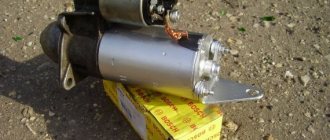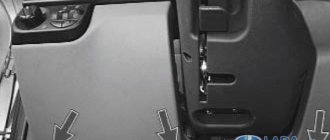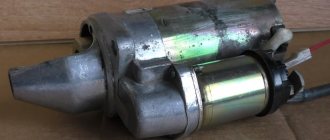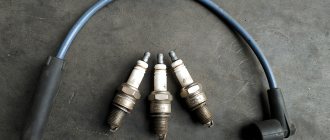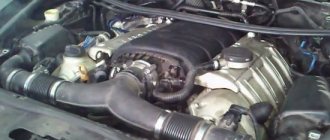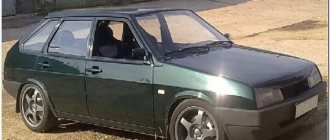Why doesn't the starter turn over when hot?
Most often, the starter does not turn when hot due to the fact that when heated, the bushings expand slightly in size, which is why the starter shaft jams or does not turn at all.
Also, the reasons that the starter does not start when hot is the deterioration of electrical contacts in the heat, contamination of its internal cavity, violation of the contact group, and contamination of the “nickels”. To troubleshoot, you need to get rid of the listed causes. However, there are a couple of “folk” methods with which even a worn starter can be made to rotate under significant heat.
| Cause of failure | What to do |
| Bushing wear | Replace |
| Deterioration of contacts | Clean, tighten, lubricate contacts |
| Reducing the insulation resistance of the stator/rotor winding | Check insulation resistance. Eliminated by replacing the winding |
| Contact plates in the solenoid relay | Clean or replace the “nickels” |
| Dirt and dust in the starter housing | Clean the internal cavity, rotor / stator / contacts / cover |
| Brush wear | Clean the brushes or replace the brush assembly |
The starter turns poorly
Most often, the starter turns poorly due to low battery charge, poor ground contact, wear of the bushings on its body, breakage of the solenoid relay, short circuit of the stator or rotor (armature) windings, wear of the bendix, loose contact of the brushes with the commutator or their significant wear. .
Primary repair measures can be carried out without removing the unit from its seat, but if this does not help and the starter turns tightly, then it will have to be dismantled and additional diagnostics performed with its disassembly, focusing on its main malfunctions.
| What is the reason | What to do |
| Weak battery | Check the battery charge level, recharge if necessary |
| Check the condition of the battery terminals, clean them of dirt and oxides, and lubricate them with special lubricant. | |
| Battery, starter and ground contacts | Inspect the contacts on the battery itself (tightening torque), the engine ground wire, and the connection points on the starter. |
| Solenoid relay | Check the relay windings using an electronic multimeter. On a working relay, the resistance value between each winding and ground should be 1.3 Ohms, and between the power contacts 3.5 Ohms. When the windings fail, the relay is usually replaced. |
| Starter brushes | Check their level of wear. If the wear is significant, then the brushes need to be replaced. |
| Starter bushings | Inspect their condition, in particular, play. The permissible play is about 0.5 mm. If the free play value is exceeded, the bushings are replaced with new ones. |
| Stator and rotor (armature) windings | Using a multimeter, you need to check them for open circuits, as well as the presence of a short circuit to the body and an interturn short circuit. The windings are either rewinded or the starter is replaced. |
| Bendix starter | Check the condition of the Bendix gear (especially for old cars or cars with significant mileage). If there is significant wear, you need to replace the bendix with a new one. |
| Engine oil | Check the condition and fluidity of the oil using a dipstick. If summer oil is poured into the crankcase and it has thickened, then you need to tow the car to a warm box and change the oil there to winter oil. |
| The ignition is set incorrectly (important for carburetor cars) | In this case, you need to check the ignition timing and, if necessary, set its correct value. |
| Ignition switch contact group | Check the condition and quality of the contact group and connections. If necessary, tighten the contacts or replace the contact group completely. |
| Crankshaft | It is better to entrust diagnostics and repairs to specialists at a car service center, since it is necessary to partially disassemble the engine and check the condition of the liners. |
What to do if the starter does not turn on a hot engine
If the starter cannot crank the engine hot, then you need to dismantle it and check it. The diagnostic algorithm will be as follows:
“Penny” of the retractor relay
Since all these procedures require time to remove and disassemble the unit, emergency starting methods will help to get out of the situation and still start a hot engine with such a starter problem as a temporary action.
How to start the engine if the starter does not start when hot
When the starter does not turn hot, but you need to drive, there are a couple of emergency methods for starting the starter. They involve forced closure of the starter contacts directly, bypassing the ignition switch circuit. They will work only in case of problems with the retractor, contacts and slight wear of the bushings; for other reasons, you will have to wait for it to cool down.
Starter terminal location
The first, and most often used, is to close the contacts with a screwdriver or other metal object. With the ignition on, simply close the contacts on the starter housing. The contacts are located on the outside of the starter housing and the wires go to them. You need to close the battery terminal (power wire, +12 Volts) and the starter motor start terminal. You can’t touch the ignition terminal, just as you can’t short-circuit +12 V to the starter housing!
The second method involves preliminary preparation; it is used when the problem is known, but there is no opportunity or desire to deal with it. You can use a two-core cable and a normally open electrical button. Connect two wires at one end of the wire to the starter contacts, then lay the cable in the engine compartment so that its other end comes out somewhere under the “dashboard” to the control panel. Connect the other two ends of the wires to the button. With its help, after turning on the ignition, you can remotely close the starter contacts to start it.
Conclusion
The starter, before it completely fails, begins to not turn the engine when it is hot. Also, problems with starting can occur if the wires and contacts are weak. Therefore, in order not to find yourself in such an unpleasant situation, you need to monitor it and its wiring.
Source
Does the starter turn sluggishly? A simple solution to the problem, in 10 minutes and 60 rubles
Greetings, dear friends.
Problems with the starter worry many owners of not new cars. Among the most common problems you can notice the “sluggish” operation of the unit.
There are many reasons why such a problem may occur. However, today we will look at one of the most common problems, and also look at how to correctly diagnose a car for the cause of this particular malfunction.
Starter is a common problem
First, we need to understand that the starter is very much, in many cars, even the most powerful electrical device.
Accordingly, in order for this device, and especially not a new one, to work well, it needs to be well powered.
Therefore, we have a fairly wide field of all possible reasons why the starter may not turn well: a weak battery, soured contacts, partially broken wires.
It’s not difficult to check the battery - you can ask a friend for a good one or charge an old one, but with the contacts everything is a little more complicated, for this you need to get close to the starter itself.
A fairly common problem is bad mass. As a rule, sluggishness in the starter’s operation occurs precisely because of this. But how can you check whether the “mass” is really the reason?
Examination
In addition to the car, we will need one more item: a welding cable, I personally used a section of 25 (mm2). One assistant is also needed.
Your assistant sits in the driver's seat and begins to crank the starter by turning the key in the ignition.
You, at the moment when the starter has already begun to turn, take the wire and attach one end to the negative terminal of the battery, and the other to a clean place on the engine.
At the same time, try to apply it to the cast part of the motor; I do not recommend applying it to the joint of parts, since a small spark may appear during the inspection process.
Next, we carefully observe: if at the moment when you attached the wire to the battery and the engine, the starter began to turn faster, then the problem lies precisely in the “ground”.
Solving the problem (2 options)
There are two solutions to this problem.
First:
Clean the standard negative contact that goes from the battery to the engine.
In principle, I consider this option mandatory
, since the contacts need to be kept clean, and this method does not require any special investments at all.
The second
method
should be used, as a rule, only when the first did not help.
It consists of laying an additional wire
from the body to the engine.
The weight on the body is very good, unless of course the wire from the battery is broken, so it is better to take the “minus” from it.
Also lay the welding wire so that it is not too small. I needed 15-20 cm of wire, as well as two tips for it. In total, all this costs about 60 rubles.
I fixed it like this:
It also makes sense to remove the starter and clean the contacts already on it.
Source
The starter turns weakly
Design of the starting device The starter, which is light in weight, has to rotate the massive flywheel and set the entire piston group in motion.
Its operation is affected by all components included in the ignition system. The failure of one of them entails the failure of the others. For example, if the integrity of the electrical wiring is damaged, it is difficult for the starter to crank the engine. In this case, a spark jumps between the brushes, which burns out the commutator.
Before starting repairs due to the fact that the starter turns poorly, you need to rule out other possible causes of a bad start (video author Ivan Matieshin).
Possible reasons
One of the reasons may be engine oil, if the engine does not start well when cold. It may not have changed for a long time or may not correspond to the season. When it is frosty outside, you should use winter oil, which has components that take into account its operation at low temperatures. In frosty weather, summer oil thickens and becomes viscous, “gluing” the piston system.
A starting device called a starter
So, the starter performs the main task of the starting system - it ensures that the car engine starts. Today, with the help of a starter, it is possible to remotely start a car from a key fob, for example, in winter, while standing on the balcony of your apartment. By the time you get down to the car, the interior will already warm up. Thus, a modern starting device easily relieves the driver of many complex things and significantly increases driving comfort.
In terms of design, the starter is an electric motor that consumes energy from the battery. The starter then drives the machine's crank shaft when the device's bendix engages the flywheel.
In addition to the bendix, the starting device also includes other elements, such as a traction relay, an armature, etc. Thus, the starter will not be a full-fledged electric motor if the full and interconnected operation of all elements is not established.
Purpose and features of the starter
This element in the power unit starting system is necessary to spin the crankshaft, since without this procedure any vehicle simply cannot start. If for some reason the starting device stops spinning the crankshaft until it reaches the required speed, problems arise with starting the engine.
Do not confuse a non-working starter with a mechanism that does not turn the engine well, since these are two opposite states of the element. Therefore, every car owner needs to learn to distinguish between these conditions and diagnose their causes.
Before performing a device test, it is necessary to check the charge of the power source, since the correct starting of the engine depends on it. If the battery is not charged well enough, the starter will no longer be able to spin the crankshaft.
Advice! You can check the battery in various ways, the simplest of which is to measure its voltage using a voltmeter. In addition, it is also worth checking the condition of the wires that supply voltage to the terminals of the starting system, since they can also cause poor operation of the element. It is very important to determine how often this condition occurs. If it occurs once, there is no cause for concern, otherwise it is recommended to install a new battery in the car.
Causes of malfunction
If the starter turns poorly when the battery is charged, then the breakdown, in most cases, is in the engine starting device.
The reason for the low engine speed, in this case, may be:
Before you begin to identify the above reasons, you should make sure that the battery produces sufficient current to start the engine. To do this, you can use a load fork. If the battery is serviceable, it is necessary to measure the density of the electrolyte.
Wiring faults
The starter of an internal combustion engine is the most energy-intensive piece of electrical equipment in a car, so poor-quality fastening of wires and terminals can reduce the efficiency of this device.
The current strength that occurs when the starter is turned on is so high that an electric arc can form in wires that are not well attached. Part of the energy will be spent on maintaining this effect, as a result of which the starter will rotate very slowly.
Why does the starter turn poorly?
Often, car owners who are faced with a problem when the starter turns sluggishly think that the battery is “to blame” (its significant wear, insufficient charge), especially if the situation occurs at negative ambient temperatures. In fact, besides the battery, there are many other reasons why the starter takes a long time to spin the engine to start it.
- Accumulator battery . In cold weather, the battery capacity decreases and it produces a lower starting current, which is sometimes not enough for the starter to operate normally. Also, the reasons why the battery does not turn the starter well may be poor contacts at the terminals. In particular, there is oxidation on the bolts or on the battery terminals.
- Poor ground contact . Often the battery does not turn the starter well simply because of a weak contact at the negative terminal of the traction relay. The reason may lie either in a weak contact (the fastening has become loose) or contamination of the contact itself (often its oxidation).
- Wear of starter bushings . Natural wear of the starter bushings usually leads to axial play of the starter shaft and sluggish operation. When the axle warps or “slides” inside the starter housing, rotation of the shaft becomes difficult. Accordingly, the rotation speed of the engine flywheel drops, and additional electrical energy from the battery is required to spin it up.
Many car enthusiasts do not carry out diagnostics in full and rush to buy a new battery or starter, and often this does not help them. Therefore, in order not to waste money in vain, it makes sense to figure out why the starter turns sluggishly when the battery is charged and take appropriate repair measures.
Why does the anchor rotate slowly?
When such problems arise, experienced drivers first of all go to check the condition of the terminals connecting to the battery. They may be oxidized or poorly clamped. If this is the case, the problem can be solved by removing the oxides, tightening the fasteners and coating this joint with CIATIM 201 lubricant. What to do if this does not happen? You should continue to look for a bad connection.
In some car models, there is access to the starter; in this case, you should try to forcibly close the power terminals of the solenoid relay. Reliable operation of the starter will confirm the malfunction of the retractor relay, and if even after this the start is unsuccessful, you will have to remove the starting device from the car. This operation is not very labor-intensive, but on some models it is quite inconvenient to carry out. However, to troubleshoot problems you will have to do it.
Before you begin disassembling and searching for a defect in this device, you should check the connection of the power wires to the bolts of the solenoid relay. Large currents consumed by the starting device cause, in some cases, heating of this connection. After repeated occurrence of this phenomenon, contacts are broken, resulting in slow rotation of the armature. You should unscrew the nuts from both power bolts of the solenoid relay, thoroughly clean the contacts, and restore the connection again. At this time, you should also check the reliability of the connection of the power winding with the output terminal, the condition of which may make it impossible to start the engine.
Next, you should disassemble and carefully inspect all the parts of this device. After long-term use, they naturally wear out. Such parts primarily include brushes and bushings in which the armature rotates. They are made of copper-graphite alloy, which is subject to abrasion. If this happens, then during rotation of the armature it will be pressed against the power windings, which will cause braking of the rotation of the shaft. In this case, drivers say that the starter takes over.
In such cases, the worn bushings are usually pressed out, new ones are installed instead and unrolled to the required size, after which the device is assembled and tested in operation. As you can see, problems exist. We talked about some problems why the starter turns as if the battery was dead. It may happen that there are other reasons for such problems, but the ways to find them can be used from this story.
You turn the ignition key, but instead of the vigorous rhythm of the running engine, you hear that the starter is turning the engine, as if the battery is dead. Another attempt to start the engine. And further. Stop: until the battery really requires charging, and the car is not sent on a tow truck for service, it is worth remembering how to check the starter without removing it from the car, and even fix the breakdown. To identify the malfunction, you will have to remember the operating principle and design of the starter.
Diagnostics of VAZ 2106 starter faults
All starter malfunctions can be divided into two groups:
To correctly diagnose the starter, the car owner needs to know the signs corresponding to a particular malfunction.
Signs of a faulty starter
The main symptoms of starter failure include:
Common starter faults
Each symptom of a malfunction has its own causes.
When starting, the starter and traction relay do not operate
The reasons for the lack of response of the starter to turning the ignition key may be:
In such a situation, first of all you need to check the battery using a multimeter - the voltage at its terminals should not be lower than 11 V. Otherwise, you should charge the battery and continue diagnostics.
Then check the condition of the battery terminals and the reliability of their contact with the tips of the power wires. In case of poor contact, the battery terminals quickly oxidize, and the battery energy becomes insufficient to start the starter. The same thing happens with pin 50 on the traction relay. If traces of oxidation are detected, the tips are disconnected from the battery and cleaned together with the battery terminals and terminal 50.
Checking the contact group of the ignition switch and the integrity of the control wire is carried out by closing the plug of this wire and terminal B of the traction relay. In this case, power begins to be supplied directly to the starter. To carry out such diagnostics, you must have some experience. The check is carried out as follows:
The starter turns hard
The current travels from the battery to the starter a long way through the electrical network, which consists of a large number of connections and wires. During operation, oxidation processes occur, contacts and wires undergo corrosion. In addition, the wiring may burn out, which leads to disruptions in the integrity of the electrical network and interruptions or complete cessation of the supply of electric current to the starter.
Possible reasons
If the starter slips when starting, this is mainly due to damage to the contacts. First of all, you need to ring the wiring, check its integrity. Particular attention should be paid to the collector, where the wires often burn out. With prolonged use, the wiring may rot over time.
Solution
If problems are detected in the electrical network in the form of a breakdown or break, the damaged area must be completely replaced. However, you should not use electrical tape, as it will not last long.
To restore the working condition of the electrical network, it is necessary to clean the terminals and contacts in all parts of the starting system: oxidized contacts are the main reason for poor flow of electrical current.
Cleansing consists of the following steps:
Diagnostics
If the problem is not initially found, it is worth diagnosing the starter by disassembling it. To do this, you must first remove it from the system and carefully examine it.
During the removal process, it is worth checking adjacent parts. It is especially recommended to inspect the retractor relay, because this is where problems can arise. If there are oxidized contacts at the connection points, you need to clean them. It is also worth checking all connections for oxidation, because inappropriate operating conditions can cause destruction of the metal. This leads to wiring problems.
Next you need to grab the starter again. The following elements are checked in turn during the analysis process:
The remaining elements are not so important, because checking them is difficult, breakdowns often occur due to these parts. It is important to carefully diagnose their condition and interaction with other elements in order to detect possible traces of problems.
In particularly severe cases such as massive oxidation, destruction of several parts and other malfunctions, it is recommended to completely replace the starter. Even after repair, the reliability of such a device will be low, and a comprehensive repair will be more expensive than purchasing a new part.
Advice to a car owner
All external contacts of the starter should be cleaned before checking, since this is a fairly common malfunction and there is no need to remove it from the engine.
Even an initial check of the starter without removing it from the vehicle usually indicates a breakdown, reducing repair time, reducing costs and not taking much time.
In some cases, the car owner has to find out why the starter turns as if the battery is dead. This unpleasant phenomenon is associated with the starting system, and it does not matter whether the car is petrol or diesel. This happens on any machine.
The trouble is expressed in the fact that it turns out to be impossible to continue the journey. Well, let’s say we stopped on the road to go to the store for juice, but the car doesn’t want to start. What are you going to do here?
ATTENTION! A completely simple way to reduce fuel consumption has been found! Don't believe me? An auto mechanic with 15 years of experience also didn’t believe it until he tried it. And now he saves 35,000 rubles a year on gasoline! Read more"
Still, car modification matters. For example, if the car has a manual transmission, then it can be started using a pushrod. This will no longer happen with automatic transmission cars. Be that as it may, trouble is putting it mildly.
If the battery is dead, the starter does not turn because there is not enough current. This is clear to everyone. However, the reason for poor starter performance may lie elsewhere.
How to fix
After the starter is removed, you can look at the adjacent parts to see if they also need to be replaced. It is important to check the retractor relay. To check it, you need to disconnect it: unscrew two bolts and disconnect the wire from it that connects it to the starter winding. Having taken out the relay, you need to inspect it. If you need to replace it, do so. Only the new must match the parameters of the old.
Let's go back to the starter. On its back cover there are two nuts, between which there is another cover. This cover is the rotor protection. The cover must be removed to remove the retaining ring so that it does not interfere with the work of disassembling and repairing the starter. Next you need to remove the back cover. Below it is a brush mechanism. To replace new brushes with old ones, depending on the car model, you need to either solder them to the contacts or screw them. In order to remove the bushings, you need to remove them from the covers using a tube. Before installing new bushings, it is necessary to clean them from dust on the rotor. Otherwise there will be poor contact with the brushes. The bushings are installed and the starter is assembled in reverse order.
Starter diagnostics
Dismantling. Once we are convinced that this is the cause of poor rotation of the starter when cold, it will need to be removed from the car for diagnostics. It is advisable to carry out the procedure when the engine is cold, so as not to get burned on the elements of the exhaust system. Before dismantling the starter, you need to remove the terminal from the battery. Depending on what brand of your car it may be more convenient to first unscrew the mount of the starter itself, and then disconnect the power wires and the solenoid relay wire, and possibly vice versa.
Inspection. After dismantling the starter, we need to inspect it. If it is heavily soiled, we clean it. First of all, we check the solenoid relay. If we observe signs of severe wear or any visible damage, the relay should be replaced. Naturally, the new relay must be installed with the same parameters.
Disassembly. If everything is in order with the relay, we move on to the starter. It is worth considering that starters come in different designs. It is necessary to remove the rear cover of the starter, under which the brush assembly is located. The back cover at the same time protects the rotor. We evaluate the condition of the brushes and replace them if necessary. Brushes can be attached either with bolts or by soldering. In addition to the brushes, we pay attention to the bushings. If there is severe wear, the rotor warps at the moment of starting, a lot of force is created, the starter consumes a lot of current and therefore turns hard. If there is 0.5 mm play on the bushings, they should be replaced with new ones. To ensure good contact between the brushes and the rotor, the rotor must be cleaned of dust.
One of the important points is the correct diagnosis. Some people succeed easier, some more difficult, some don’t succeed at all. Much also depends on experience and whether the person has encountered this problem before. There are also car owners for whom such words as “starter” and “generator” are something completely incomprehensible. The article is intended for those who have decided to independently search for the causes of poor engine starting with a starter and eliminate them.
Friends, remember: despite the fact that a car is just hardware, it nevertheless requires periodic attention. Only in this case can we talk about reliability and be confident in your car. Good luck to everyone on the roads!
The car won’t start – we check the main possible problems
The most common problem with a vehicle's engine or electrical system is a lack of ignition. There are different options for the implementation of this breakdown, so you need to know the difference in order to determine the specific unit to blame for the failure to start the engine. The starter may spin, click or be silent, the engine may start and immediately stall, and also make sounds that are unusual for it. It is worth dealing with these manifestations so as not to make the breakdown even more complicated.
Firstly, if the car does not start, you should stop trying to start the engine until the problem is clarified. The timing belt may have broken on the car, and your successive attempts to start the engines will lead to valve failure. Let's look at the main possible manifestations of problems that cause poor engine starting.
Problems with the starter and electrical system of the car
Often the answer to the question of why the car won’t start lies on the surface. Poor performance of the starter or its complete failure is the cause of 80 percent of problems with starting the power unit. Therefore, first of all, check this unit for its correct operation.
Also, starting the engine can be complicated by a dead battery or a broken wire in the car's electrical system. The wire leading from the battery to the starter often breaks, and the car does not respond at all to turning the key in the ignition. Manifestations of problems with the starter are as follows:
In the latter case, the culprit of the problem will be the bendix, which should move out of the starter and turn the engine. This element often wears out and does not perform its tasks. The first types of problems are related to the solenoid relay. Replacing it can often solve this problem.
If your car's battery is dead, the starter will only turn once or twice without starting the engine. Lazy sounds under the hood also mean a dead battery. In all these cases, you can easily start the car from a pusher or with the help of a tow, and in the event of a battery failure, you can light a cigarette from the battery of another car.
Problems when starting the engine related to the power unit system.
Often problems with starting the engine are based on problems with the unit itself, and in this case you need to be much more attentive to extraneous sounds and other possible manifestations of the problem. If the engine knocks during startup, a possible problem is hidden in the piston group or in the valves. The ignition setting may also be lost.
Here everything depends not only on the operating characteristics of the car, but also on the type of engine itself. In some units you can try to find the problem yourself; in the case of modern foreign equipment, you will have to evacuate the car to a service station. The main problems that occur in the engine system and prevent the car from starting are the following:
Also, the car may well not start due to low octane gasoline or poor fuel quality. Diesel engines can be difficult to operate in winter due to possible fuel freezing. The more technology and automatic solutions are present in a car, the more possible problems can be found.
If you understand that the problem of the power unit not starting is not related to the battery or starter, stop trying to start the engine, because you can only make things worse. It is better to invite a specialist or tow the car to a professional station to detect and fix problems.
See what a broken timing belt can lead to on some cars:
Let's sum it up
If your car refuses to start, you shouldn’t torture it with every second attempts to turn the key in the ignition system in an effort not to be late for work. Use the services of a specialist to identify possible problems and get more information about the problem. Then you can easily detect the breakdown and fix it.
If the engine does not start for more serious reasons, the service station will tell you possible ways to fix the problem. It is enough to find specialists who are well versed in your make and model of car. Are there any situations in your driving experience when it was very difficult to determine the reasons for the failure of the power unit to start?
Many motorists have found themselves in an unpleasant situation in the morning when the car does not start. For example, the starter does not click, but it turns or turns with difficulty. Why is this happening? The reason may be a malfunction of the ignition system. The article discusses situations where the starter spins for a long time and provides ways to eliminate the problem.
Possible reasons
So, let's figure out why a cold starter turns poorly in winter?
Initially, the difficulty in identifying a malfunction is that the car’s starting system includes a lot of additional elements. Therefore, there is no point in immediately sinning on any particular detail. After all, something else could have gone wrong. So, let's look at the elements that are part of or at least somehow affect the ignition system, their role, and the possibility of failure:
- The power source, of course, is the battery. It allows the starter to rotate;
- The network is closed between the ignition switch and the relay and the energy is directed to the solenoid relay and to the winding;
- Having received energy, the solenoid relay starts the Bendix operating gear into engagement with the flywheel. In this way, the contacts are closed and current is supplied;
- Before starting, the starter starts the engine flywheel and the elements of the connecting rod and piston group with the gas distribution mechanism.
I have provided this list so that you can clearly see how many elements are used in the ignition system to start the car. That is why it is not easy to determine the real reason why the starter does not turn when cold.
Starting a car engine, especially in the cold season, at low temperatures, is often a problem for a motorist. To avoid this, it is necessary to inspect two things from time to time: the battery charge and the viscosity of the engine oil.
Due to the low temperature (below zero), the flow of physical and chemical processes in the battery cells slows down significantly, which makes charging it take much longer. And also the oil, which is located in the lubrication system, becomes thick and very viscous, and therefore, in order to successfully start the engine, you have to warm up the block yourself using improvised means. To protect yourself and make winter enjoyable, you need to change the oil to winter oil in the spring.
Only in the case when the starter does not turn when cold or turns weakly, but when warming up it seems to get a second wind, it is necessary to carry out a series of diagnostic work. The first step is to recharge the battery (if it has lost charge). Perhaps it is the lack of charge that is the cause, since the battery cannot provide power. In the case when the power supply is either new or perfectly charged, but the starter still does not work, we continue our search.
Now you need to check for contact between the starter housing and ground. Oxidation of the contacts often occurs, which leads to a large loss of current, and the starter receives nothing. It is necessary to double-check all connections, from the terminals on the battery to the starter. Oxidized tires between the body and the engine must be replaced. After making good contact, you can try to start the car again. If this small repair did not help, then the problem is clearly in the starter: the brushes or bushings, which play a big role in functionality, because they are the bridge for transmitting power to the starter rotor, could be worn out.
How to dismantle, disassemble and check the starter
Dismantling the starter device is not so difficult, but on some car models it is extremely inconvenient to remove it.
Before actual dismantling, it is recommended to test the quality of the connection of the armored wiring to the bolts of the traction relay. Heating of connections and their subsequent damage can be caused by the large amount of current consumed. Obviously, broken contacts are the reason for the slow rotation of the armature.
If everything is in order with the power wires, you need to start dismantling.
VAZ 2106 starter repair
Most faults in the VAZ 2106 starter can be fixed on your own - all the necessary elements for this are available for sale. Therefore, if the symptoms described above appear, you should not immediately replace the starter with a new one.
Removing the starter
To remove the VAZ 2106 starter you will need:
The starter itself is dismantled in the following order:
- Use a Phillips screwdriver to unscrew the clamp screw on the air intake hose. Remove the hose from the air filter pipe and move it to the side.
Video: dismantling the VAZ 2106 starter
Disassembly, troubleshooting and repair of the starter
To disassemble, troubleshoot and repair the VAZ 2106 starter you will need:
The work is performed in the following order:
- Using a 13mm wrench, unscrew the nut securing the wire to the lower terminal of the traction relay.
Video: disassembling and repairing the VAZ 2106 starter
Reasons for slow rotation
We are interested in the moment when the starter rotates at low speed. This makes starting the internal combustion engine problematic. A priori, the reason for this behavior of the starter is related to the battery, the condition of which leaves much to be desired, but this is not the point. Let's assume that the battery is reliable, the acid has been replaced and the charge is present.
The reason for the starter turning slowly may be due to things like oxidation of the terminals or loose connections. In this case, it is recommended to clean the oxides, tighten the clamps and treat the elements with a suitable lubricant. If starting does not improve, you need to continue troubleshooting.
Many vehicles have easy access to the starter device and its traction relay. In this case, it will be much easier to check whether the starter is working if you start it directly. In other words, the closure of the power terminals of the relay is carried out forcibly, which will make it possible to confirm the malfunction of the solenoid relay (VRS) based on reliable operation of the starter. On the contrary, if the start is unsuccessful, the starter will have to be removed and repaired.
Source
